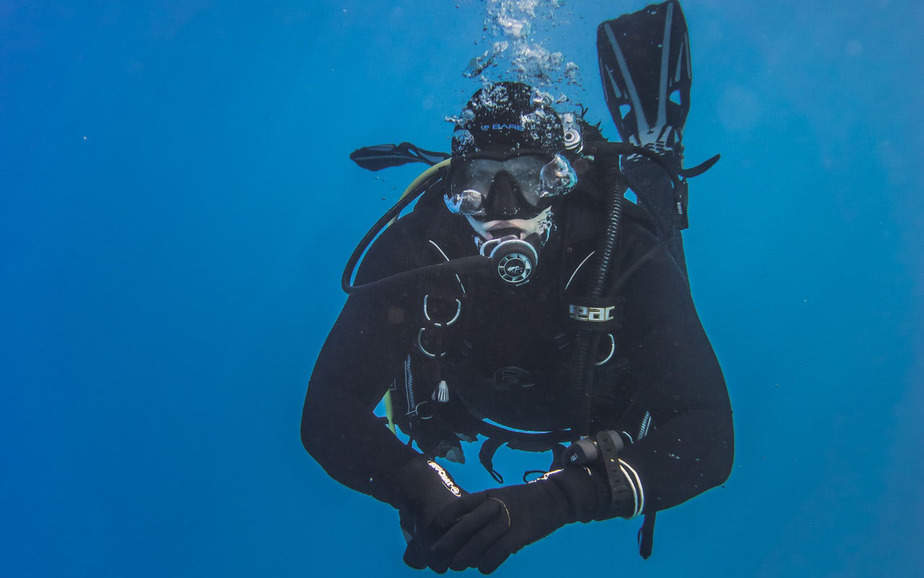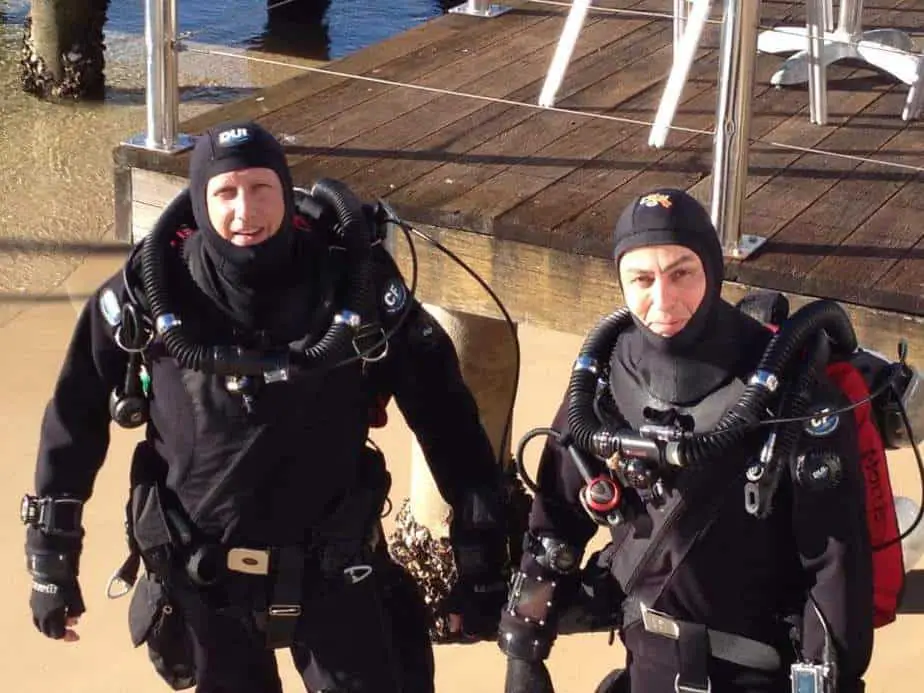Recreational scuba divers dive using a regulator and they are classified as open-circuit. However, more advanced divers often switch to a different breathing apparatus known as a closed-circuit rebreather (CCR) or simply a rebreather. While regulators are the more common breathing apparatus, perhaps one day you will advance to a rebreather and would like to know the differences between the two. In this article, we’ll look at the benefits of open-circuit and closed-circuit diving and how these two differ.
What is open-circuit diving? (Diving with a regulator)
Most recreational diving is open-circuit, meaning it involves using a regulator. A very basic gas mixture used consists of 21% oxygen, 78% nitrogen, and 1% various gases like argon. For nitrox diving, gas mixtures consisting of more than 21% oxygen will be used. Regardless of what gas mixture they use, in open-circuit diving none of the gas that is exhaled is recycled.
Have you ever noticed how when you exhale with a regulator, bubbles come out of the exhaust? That’s because the gas isn’t recycled or reused in open-circuit diving. The gas is stored in the tank, travels through the regulator and into the lungs, then it is exhaled into the surrounding sea. The exception is when you’re wearing a buoyancy control device (BCD), in which case the gas may pass to the BCD to improve buoyancy.
To sum it up, the defining feature of open-circuit diving is that the breathing gas is not reused or recycled. After the gas goes from the tank to your lungs and you exhale, it’s just released into the sea or transferred to your BCD.
What is closed-circuit diving? (Diving a rebreather, CCR)
In a fully closed-circuit rebreather, a small tank of mixed gases (oxygen and nitrogen or oxygen and helium) or pure oxygen will be injected into your breathing loop. No gas ever leaves the system, hence it is fully-closed.
In a semi-closed circuit rebreather, only some of the gases you exhale are reused and replaced with fresh breathing gas (oxygen, nitrox, or trimix) that is injected into the breathing loop. The rest are released. The benefit of a semi-closed circuit rebreather is that the setup is much simpler. The downside is that it may lack gas monitoring capabilities and increase the risk of something going wrong.
Closed-circuit diving involves the use of a rebreather, plus some other equipment, which partially or completely recycles all of the breathing gas. They allow you to dive using smaller gas tanks which decreases bulk and drag.
Rebreathers, like open-circuit regulators, also have a mouthpiece which you inhale and exhale through while underwater. When you inhale, the gas will be transferred from the tank and depressurized so that it’s safe to breathe.
Where closed-circuit rebreathers differ from open-circuit regulators is when you exhale. The gas doesn’t get sent out to the sea; instead, it gets cleaned and sent back to the tank so that it can be reused. Get why it’s called a rebreather now?
A rebreather is not just a mouthpiece, and we drastically simplified the part where the gas goes from your lungs back to the tank. As we mentioned, the air must be cleaned up first. There is an entire system with many components which makes this possible. Specifically, one of the components is the carbon dioxide scrubber which removes the carbon dioxide from the gas and then sends the air to the counterlungs.
Below, we go over each component that comprises the rebreather.
Mouthpiece
A mouthpiece is, of course, still necessary for CCR diving. It is the component which you inhale and exhale through. Like any other mouthpiece, you hold it in place by biting down on the top and bottom with your teeth. You need to make sure the fit is good, otherwise it will cause jaw fatigue and pain.
Hoses
There are several hoses which provide the diver with gas when they inhale, and recycle the diver’s used gas when they exhale. They are generally constructed from flexible and durable synthetic rubber. Rebreather hoses attach the mouthpiece to other components such as the counterlungs and gas tank.
Carbon Dioxide Scrubber
As we mentioned previously, the carbon dioxide scrubber is an essential component of the rebreather that removes the carbon dioxide from the gas that leaves the diver’s lungs. When you exhale, the exhaled gas will have less oxygen than when you inhaled and more carbon dioxide.
If we tried breathing that again under normal circumstances, we’d be breathing in a lot of carbon dioxide instead of oxygen and we’d suffocate. The carbon dioxide scrubber will remove the carbon dioxide from this air before sending it to the counterlungs.
Counterlungs
Yet another essential component of the rebreather is the counterlungs. This component helps divers breathe gas by maintaining the same pressure as the diver’s lungs (tidal volume).
Over-Pressure Valve
Not all rebreathers have this component, however some of them will come with an over-pressure valve. This component is mounted on the counterlungs and allows the diver to release some gas from the breathing circuit during the ascent. If the gas is not let out during an ascent, then the trapped gas will expand and potentially cause a critical equipment failure.
Gas Tank
Lastly, all rebreathers have a gas tank where the breathing gas is stored and recycled back into. The defining feature of closed-circuit diving is that the gas is fully or at least partially recycled. On the other hand, open-circuit regulators do not recycle the breathing gas.
Benefits of open-circuit diving

For recreational divers, open-circuit diving is the obvious choice because of its lower cost and ease of use. There’s already a lot to worry about when you’re starting out, so simple is best. With a regulator, you don’t have to worry about components like the overpressure valve or the carbon dioxide scrubber failing. You also don’t have to worry about maintaining or replacing those components.
Another huge benefit of using a regulator is how comparatively cheap it is. It can still cost several hundred dollars, even on the low end. However, rebreathers will cost several thousand dollars; it’s just not in the same price range. The price difference is due to the complicated components inside a rebreather.
Benefits of closed-circuit diving
Though closed-circuit diving is much more complicated and expensive than open-circuit diving, it comes with several powerful advantages, one of which is a much longer bottom time. In a study, it was found that open-circuit divers consumed 17 times as much gas as closed-circuit divers. Since the gas in a CCR is recycled, closed-circuit divers can stay underwater for much longer than open-circuit divers.
Furthermore, despite the significantly higher initial cost of a rebreather, it doesn’t quite tell the whole story when it comes to repeat expenses. In the same study cited above, it was found that open-circuit setups “cost 7 times more in expendables” and “4 times as much topside equipment preparation”. Time is money, after all, and these expenses can add up.
Another distinct advantage of closed-circuit diving is that it is almost completely silent. In a fully closed-circuit rebreather, the gas is not released, which means you don’t have to worry about disruptive bubbles scaring away all of the aquatic life you are observing.
Are rebreathers dangerous?
Rebreathers are not inherently dangerous. They have some safety risks and the most major one is that there’s no backup if one of the components of the rebreather suffers a failure underwater; the consequences can be fatal. Furthermore, rebreathers are commonly used in extreme forms of scuba diving, such as wreck and cave diving, which are already inherently risky.
In an open-circuit system, when the regulator malfunctions you can switch to using the octopus or switch to a redundant air source easily. There’s no plan B for CCR diving, so you better make sure that the components are well-maintained and in proper working order prior to diving.
Certifications
Closed-circuit diving is more advanced and thus requires additional training and certifications to improve your proficiency. For example, PADI offers a Rebreather Diver Course. The requirements to sign up are that you have already passed the Open Water Diver course and the Enriched Air Diver course, are at least 18 years of age, with 25 or more logged dives.
In the course, you will get comprehensive training on the mechanics of closed-circuit diving, how to perform bubble checks, how to check your rebreather, monitoring gauges, optimizing your BCD and more.
Furthermore, TDI also offers their Closed Circuit Rebreather Air Diluent Diver course. To be eligible to take this course, you’ll need to have passed their Nitrox Diver course, be 18 years of age, with 20 or more logged dives.
As part of the course, you’ll learn about the history of breathers, differences between open-circuit regulators and closed-circuit rebreathers, dive tables, equipment procedures and so on.
Whether you take the PADI Rebreather Diver course or TDI’s CCR Air Diluent Diver course, you will learn some very important information that will make you a safer and better diver. It will take an investment of time and money, but it’s worth it if you want to dive a rebreather.
Parting words
Scuba divers are able to breathe underwater using a breathing apparatus that transfers gas from the tank to their mouthpiece. In an open-circuit system, once the air is consumed, it is simply released into the surrounding area. In a closed-circuit system, the rebreather will reuse some or all of the exhaled gas.
Regardless of which setup you have, both open and closed-circuit diving offer their own unique experiences. If you’re just starting out, you should just stick with using a regulator until you have a few dives under your belt. Only after you’ve mastered the basics should you even consider tackling closed-circuit diving.


